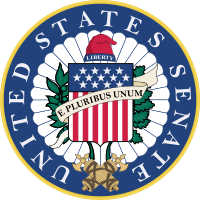Seal of the United States Senate
| Seal of the United States Senate | |
|---|---|
 |
|
| Details | |
| Armiger | United States Senate |
| Adopted | 1886 |
| Crest | Liberty Cap |
| Escutcheon | Arms of the United States |
| Supporters | Olive & Oak branches |
| Motto | E pluribus unum |
| Other elements | Fasces |
| Earlier versions | 1798 & 1831 |
| Use | Sealing of Senate documents, and by the Senate Majority and Minority Leaders |
The Seal of the United States Senate is the seal officially adopted by the United States Senate to authenticate certain official documents. Its design also sometimes serves as a sign and symbol of the Senate, appearing on its official flag among other places. The current version dates from 1886, and is the third seal design used by the Senate since its inception in 1789. The use of the seal is restricted by federal law and other regulations, and so is used sparingly, to the point that there are alternate, non-official seal designs more commonly seen in public.
The seal has a shield with 13 stars on top and 13 vertical stripes on the bottom, with a scroll inscribed with E pluribus unum floating across the top. An olive branch, symbolizing peace, graces the left side of the shield, while an oak branch, symbolizing strength, is on the right. A red liberty cap above the shield and crossed fasces below the shield represent freedom and authority, respectively. Blue beams of light emanate from the shield. Surrounding the seal is the legend "United States Senate". Several of the elements are derived from the Great Seal of the United States.
The seal is affixed to impeachment documents and resolutions of consent to international treaties. It also appears on presentation copies of Senate resolutions recognizing appointments, commendations, and notable achievements. Other uses include authentication of senator credentials, and also electoral votes for President and Vice President. The seal is kept in the custody of the Secretary of the Senate, who also can authorize other specific uses. In the twentieth century, the Secretary has authorized its official use by the majority and minority leaders.
...
Wikipedia
